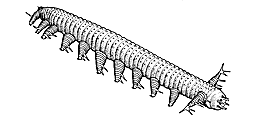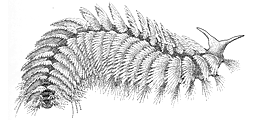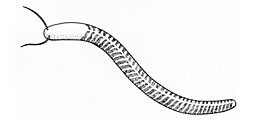The Case for a Creator, Chapter 3
Jonathan Wells’ second “icon” is Darwin’s tree of life, which he says is a “dismal failure” [p.43] as an illustration of the fossil record.
With a lead-in like that, you’d expect a typical creationist jeremiad against transitional fossils. In fact, that’s not what we get. The focus of Wells’ complaint is about the Cambrian explosion, 550 million years ago. No transitional series more recent is treated here: not the origin of tetrapods, not the therapsids which illustrate the evolution of reptiles into mammals, not the beautiful and compelling whale transitional series, and certainly not the emergence of the human species. Wells never even mentions these compelling, and indisputably relevant, examples of evolutionary transition preserved in the fossil record. Instead, the source of his ire dates all the way back to the origins of modern phyla:
“Darwin knew the fossil record failed to support his tree. He acknowledged that major groups of animals – he calls them divisions, now they’re called phyla – appear suddenly in the fossil record. That’s not what his theory predicts.” [p.43]
This is a lie. For the record, Darwin was well aware of the imperfection of the fossil record, and devoted an entire chapter of his book to explaining why we should not expect to see clear transitions preserved. If anything, he was too pessimistic, and our paleontological surveys have surpassed his expectations.
“Then at the beginning of the Cambrian – boom! – all of a sudden, we see representatives of the arthropods, modern representatives of which are insects, crabs, and the like; echinoderms, which include modern starfish and sea urchins; chordates, which include modern vertebrates; and so forth. Mammals came later, but the chordates – the major group to which they belong – were right there at the beginning of the Cambrian.
This is absolutely contrary to Darwin’s Tree of Life. These animals, which are so fundamentally different in their body plans, appear fully developed, all of a sudden…” [p.44]
Wells’ argument is that the various phyla are so different in their body plans, they could not possibly have all diverged from a common ancestor in such a brief period of time. The best answer to this is a clever analogy originally proposed by Richard Dawkins to clear up just this sort of confusion:
Suppose you have a great oak tree with huge limbs at the base and smaller and smaller branches toward the outer layers where finally there are just lots and lots of little twigs. Obviously the little tiny twigs appeared most recently. The larger boughs appeared a long time ago and when they did appear, they were little twigs. What would you think if a gardener said, “Isn’t it funny that no major boughs have appeared on this tree in recent years, only small twigs?”
Strobel and Wells would like their readers to believe that the various phyla were already radically different from each other at the time of the Cambrian explosion. This is not the case.
The phyla are like the twigs on Dawkins’ tree. Originally, far back in the Cambrian, they were very similar to each other. But over great spans of geological time, they have diverged farther and farther, and what were originally slight differences became accentuated by evolution to fit the varying lifestyles to which they adapted. Today, the living representatives of these groups have major differences from each other, and looking all the way back, we can see how those differences developed from what were originally slight distinctions. In that sense, it’s fair to say that the “fundamental body plans” first appeared in the Cambrian. But that’s not the same thing as saying that the earliest members of these groups were radically different when they lived side by side.
When Wells speaks of “major groups”, he subtly misleads the reader. Based on his examples, a lay reader might erroneously conclude that starfish, crabs, reptiles, insects, and the like all just suddenly appeared during the Cambrian. In fact, as already stated, most species of the Cambrian explosion were relatively similar, and none of them looked much at all like the modern groups that are thought to have descended from them. Here are several Cambrian animals that Wells claims represent “major groups” that are “fundamentally different in their body plans”. Can you tell which one is the ancestor of what modern group?
 |
 |
 |
(All images from the Smithsonian’s Burgess Shale Fossil Specimens page.)
If you’ve given up, the first of these animals is called Aysheaia, and is thought to be an ancestor of the velvet worms (phylum Onychophora), segmented worm-like animals with rows of clawed feet. The second is Canadia, believed to be an ancestor of annelids (phylum Annelida), whose modern representatives include earthworms and leeches. And the last is Pikaia, believed, with some dissenters, to be an ancestor of the phylum Chordata – us. All modern animals with dorsal nerve cords – fish, amphibians, reptiles, birds, mammals – all of them were represented in the Cambrian by this tiny, one-inch-long free-swimming creature.
These supposedly vast phylum-level differences, in the beginning, were trifling things. It’s only time and evolution that have turned these small twigs into great branches spreading far and wide.
Other posts in this series: